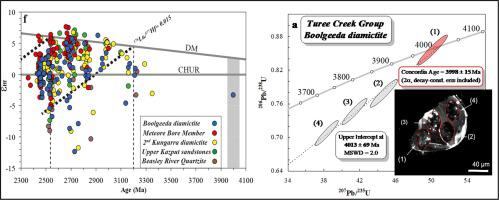当前位置:
X-MOL 学术
›
Precambrian. Res.
›
论文详情
Our official English website, www.x-mol.net, welcomes your feedback! (Note: you will need to create a separate account there.)
Lu-Hf systematics of 4.0 – 2.3 Ga old zircons from the Turee Creek Group (Pilbara Craton, W. Australia): Implications on the rise of atmospheric oxygen and global glaciation during the Paleoproterozoic
Precambrian Research ( IF 3.8 ) Pub Date : 2020-09-01 , DOI: 10.1016/j.precamres.2020.105859 Tom Caquineau , Jean-Louis Paquette , Abdelmouhcine Gannoun , Pascal Philippot
Precambrian Research ( IF 3.8 ) Pub Date : 2020-09-01 , DOI: 10.1016/j.precamres.2020.105859 Tom Caquineau , Jean-Louis Paquette , Abdelmouhcine Gannoun , Pascal Philippot

|
We investigated the Hf isotopic systematics of detrital zircons in a succession of siliciclastic sediments and glacial diamictites from the early Paleoproterozoic sequence of the Boolgeeda Iron Formation (Hamersley Group) and overlying Turee Creek Group of the Pilbara Craton, Western Australia. About 400 detrital zircons yielding >95% concordant U-Pb ages were analyzed for Hf isotopes to constrain their magmatic sources. 70% of the analyzed zircons display super-chondritic initial Hf isotopic compositions, demonstrating crystallization in mantle-derived magmas. Most of the data are comprised between model age lines at ~2.5 and 3.2 Ga, which suggests a sub-continuous crust generation by extraction from the depleted mantle during this time period. A single grain yields a 4.0 Ga age, which represents the first Hadean age for a zircon from the Pilbara Craton. Our results are significantly different from zircon Hf isotope data of the Glenburgh Terrane, in the southern border of the Turee Creek Group, or older successions of the Pilbara, Kaapvaal and Superior cratons, but show overlap with some of the Yilgarn Craton. This together with the occurrence of a Hadean zircon crystal preserved in the Boolgeeda glacial diamictite with similar Hf isotopic signature than the Jack Hills zircons makes the Yilgarn Craton a possible source material for the Boolgeeda glacial horizon. Alternatively, the majority of the zircons analyzed show ages which are consistent with those of the underlying 2.45–2.78 Ga Hamersley and Fortescue groups, formed by sedimentary successions interleaved with thick subaerial volcanic sequences associated with the emplacement of Large Igneous Provinces. Such subaerial volcanic rocks could account for the relatively juvenile character of the zircon analyzed. A local provenance of the siliciclastic material delivered to the Turee Creek Basin would support the role of large subaerial magmatic provinces as triggers of the rise of atmospheric oxygen and the onset of glaciations at the beginning of the Proterozoic.
中文翻译:

来自 Turee Creek Group(皮尔巴拉克拉通,澳大利亚)的 4.0 – 2.3 Ga 古老锆石的 Lu-Hf 系统学:对古元古代大气氧含量增加和全球冰川作用的影响
我们研究了来自 Boolgeeda 铁组(Hamersley Group)和上覆的 Pilbara Craton 的 Turee Creek Group 的早古元古代序列的一系列硅质碎屑沉积物和冰川混叠岩中碎屑锆石的 Hf 同位素系统学。分析了大约 400 颗碎屑锆石的 Hf 同位素,以限制其岩浆来源,产生 >95% 一致的 U-Pb 年龄。70% 的分析锆石显示超球粒陨石初始 Hf 同位素组成,表明在地幔衍生的岩浆中结晶。大多数数据包含在~2.5 和 3.2 Ga 的模型年龄线之间,这表明在此期间通过从耗尽的地幔中提取产生了次连续地壳。单粒产生 4.0 Ga 年龄,这代表了来自皮尔巴拉克拉通的锆石的第一个冥界年龄。我们的结果与 Glenburgh Terrane、Turee Creek Group 南部边界或 Pilbara、Kaapvaal 和 Superior 克拉通的更古老系列的锆石 Hf 同位素数据显着不同,但显示出与一些 Yilgarn 克拉通的重叠。再加上 Boolgeeda 冰川混叠岩中保存的 Hadean 锆石晶体的 Hf 同位素特征与 Jack Hills 锆石相似,这使 Yilgarn Craton 成为 Boolgeeda 冰川地平线的可能来源材料。或者,大多数分析的锆石显示的年龄与潜在的 2.45-2.78 Ga Hamersley 和 Fortescue 组的年龄一致,由沉积层序与厚厚的地下火山序列交错形成,这些火山序列与大型火成岩省的侵位有关。这种地下火山岩可以解释所分析的锆石相对年轻的特征。输送到 Turee Creek 盆地的硅质碎屑材料的本地来源将支持大型地下岩浆区作为大气中氧气上升和元古代初期冰川作用开始的触发器的作用。
更新日期:2020-09-01
中文翻译:

来自 Turee Creek Group(皮尔巴拉克拉通,澳大利亚)的 4.0 – 2.3 Ga 古老锆石的 Lu-Hf 系统学:对古元古代大气氧含量增加和全球冰川作用的影响
我们研究了来自 Boolgeeda 铁组(Hamersley Group)和上覆的 Pilbara Craton 的 Turee Creek Group 的早古元古代序列的一系列硅质碎屑沉积物和冰川混叠岩中碎屑锆石的 Hf 同位素系统学。分析了大约 400 颗碎屑锆石的 Hf 同位素,以限制其岩浆来源,产生 >95% 一致的 U-Pb 年龄。70% 的分析锆石显示超球粒陨石初始 Hf 同位素组成,表明在地幔衍生的岩浆中结晶。大多数数据包含在~2.5 和 3.2 Ga 的模型年龄线之间,这表明在此期间通过从耗尽的地幔中提取产生了次连续地壳。单粒产生 4.0 Ga 年龄,这代表了来自皮尔巴拉克拉通的锆石的第一个冥界年龄。我们的结果与 Glenburgh Terrane、Turee Creek Group 南部边界或 Pilbara、Kaapvaal 和 Superior 克拉通的更古老系列的锆石 Hf 同位素数据显着不同,但显示出与一些 Yilgarn 克拉通的重叠。再加上 Boolgeeda 冰川混叠岩中保存的 Hadean 锆石晶体的 Hf 同位素特征与 Jack Hills 锆石相似,这使 Yilgarn Craton 成为 Boolgeeda 冰川地平线的可能来源材料。或者,大多数分析的锆石显示的年龄与潜在的 2.45-2.78 Ga Hamersley 和 Fortescue 组的年龄一致,由沉积层序与厚厚的地下火山序列交错形成,这些火山序列与大型火成岩省的侵位有关。这种地下火山岩可以解释所分析的锆石相对年轻的特征。输送到 Turee Creek 盆地的硅质碎屑材料的本地来源将支持大型地下岩浆区作为大气中氧气上升和元古代初期冰川作用开始的触发器的作用。


























 京公网安备 11010802027423号
京公网安备 11010802027423号